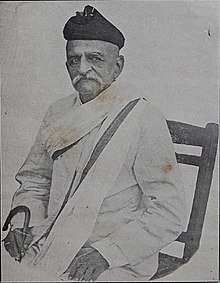Kamlashankar Trivedi
Kamlashankar Pranshankar Trivedi (11 October 1857 – 1925) was Gujarati language editor and grammarian.

Life
Kamlashankar was born on 11 October 1857 at Surat. He completed his primary and secondary education in Surat. He passed matriculation in 1874. He completed Bachelor of Arts in economy and history from Alphenston College in 1878. Due to poor financial condition, he joined as an extra teacher in Mission School, Surat. Later he taught in primary and secondary level at Bharuch, Nadiad, Surat, Ahmedabad, Bhavnagar, Bombay and Pune.[1]
He served as a principal of Premchand Raichand Training College in Ahmedabad in 1902 and edited Gujarat Shalapatra. He served as an examiner of Sanskrit in University of Bombay and Panjab University. He retired in 1914. He presided seventh session of Gujarati Sahitya Parishad in 1924.[1]
He died in 1925.[1]
Works
He was educated in economy and history while he taught Sanskrit. He published several works on grammar and translated several Sanskrit works. His editing is influenced by Sanskrit.[1][2]
He wrote England no Tunko Itihas (1887), Gods of India (1913), Shiksahnshastrana Mooltatvo (1913), Shankar Jayanti Vyakhyanmala (1913), Gujarati Bhashanu Vyakaran (1914-16), Karakmimansa (1915), Madhyam Vyakaran (1917) and the forty chapters Gujarati grammar, Brihad Vyakaran (1919).[3][4] He wrote the short history of India titled Hindustan no Sankshipta Itihas (1920). His works Kavyasahitya Mimansa (1930) and Anubhavvinod (1933) published posthumously.[1] He translated Samuel Smiles's Duty into Gujarati.[5]
He edited several textbooks; Sanskrit Book 1-2 (1896), Sanskritshikshika (The Sanskrit Teacher, 1911),[6] Sahityamanjari (1915), Gujarati/Trivedi Vanchanmala (1921).[1]
He edited Bhaṭṭikāvya (1898), Jagannath's Rekha Ganit (1901-1902), Vidyadhar's Ekavali (1908), Vishwanath's Prataprudryashobhushan (1909),[7] Lakshmidhara's Shadbhashachandrika (1918),[8] Ramchandra's Prakriyakaumudi,[9] Varruchi's Prakrit Prakash, Kond Bhatt's Vyakaranbhushan.[1]
See also
References
- "સવિશેષ પરિચય: કમળાશંકર ત્રિવેદી, ગુજરાતી સાહિત્ય પરિષદ". Gujarati Sahitya Parishad (in Gujarati). Retrieved 24 June 2015.
- Nagendra (1986). Literary criticism in India and Āchārya Shukla's theory of poetry. National Pub. House. p. 40.
- University of Sind. Economics Society (1950). Calendar. p. 430.
- University of Bombay (1929). Bombay University Handbook. p. 64.
- Artist, Purushottam Vrajlal. ગુજરાતના સાક્ષરો [Who's who of Gujarati Writers] (in Gujarati). p. 166.
- Bhave, Vinoba; Balakrishnan, V (24 June 2012). "The Sanskrit Teacher Kamalashankar Trivedi Parts 1 & 2". Internet Archive. Retrieved 24 June 2015.
- "Prtaparudrayaobhaam : Vidyntha, courtier of Pratparudra". Internet Archive. 5 October 2010. Retrieved 24 June 2015.
- "Sadbhasacandrika : Lakshmidhara, Charakuri, son of Yajñesvara". Internet Archive. 9 July 2007. Retrieved 24 June 2015.
- Shesh., Sri Ramachandra (18 January 2014). "Prakriya Kaumudi : Sri Ramachandra Shesh". Internet Archive. Retrieved 24 June 2015.